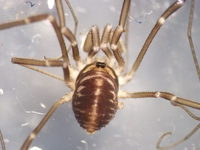Distribution Records
PDF
Vetting Levels |
|
Adult phenology:
High Mountains (HM) ≥ 4,000 ft.
Low Mountains (LM) < 4,000 ft.
Piedmont (Pd)
Coastal Plain (CP)
Click on graph to enlarge
|
 |
|
| synonym | |
| taxonomic_comments |
One of 11 species in this genus that occur in North America north of Mexico (Cokendolpher and Lee, 1993; Holmberg and Buckle, 2019). Three species occur in the East and two in North Carolina. |
| species_comment |
A recent molecular phylogeny study (Schönhofer et al., 2013) revealed that this species is much more closely related to Sabacon species in Europe than it is to S. mitchelli, with which it is sympatric at the two locations where that species has been recorded. Based on this result, plus other distinct clusterings of species, they suggest that splitting Sabacon into several different genera may be warranted. |
| id_comments |
Sabacon species are minute harvestmen distinguished by their enlarged, bristly pedipalps (Shear 1975). Sabacon cavicolens is yellowish-brown dorsally, bordered by brownish purple on the sides of the cephalothorax; the abdomen mottled with dark purplish brown and has segmental rows of light spots in the males and stripes in the females (Shear, 1975). Mitchelli, in contrast, is light, purplish brown, with yellow shading on the carapace and abdomen above, but with no patterning evident. |
| total_length |
2.4 mm, male; 5.2 mm, female (Shear, 1975) |
| structural_features |
Both sexes are much larger than those of S. mitchelli, which can be sympatric. Males have a rounded gland on the chelicera which S. mitchelli lack. Females have all of their abdominal tergites with sclerotized patches; only the first two are sclerotized in S. mitchelli (Shear, 1975). The abdomen is covered with rows of stout, black setae. |
| silk_web |
|
| fld_guide_descriptions |
|
| online_photos |
BugGuide |
| prey |
|
| predators |
|
| behavior |
|
| distribution_reference |
Crosby ad Bishop (1924) |
| technical_reference |
Shear (1975) |
| adult_id | 1 identifiable by photo 2 identifiable by photo of specific features and/or supplementary info 3 identifiable from specimen only |
| abundance |
Several individuals are often collected on a given occasion; it appears to occur fairly frequently in the right habitats |
| distribution_comments |
Probably occurs throughout our mountains. This species occurs as far south as South Carolina in the mountains and has been recorded at Greenville in the Piedmont (Hoffman, 1955). It ranges northward in the Appalachians to Virginia but also has populations in the Ohio Valley, the Great Lakes region, and New England (Shear, 1975). |
checklist_mt_high
>=4,000 ft. | |
checklist_mt_low
<4,000 ft. | |
checklist_pd
Piedmont | |
checklist_cp
Coastal Plain | |
| habitat |
In North Carolina, Shear (1975) reports finding this species in Spruce-fir forests at the highest elevations in our mountains. High humidity appears to be a key habitat factor and at lower elevations, they may be limited to moist shaded forests. |
| observation_methods |
Shear (1975) reports collecting this species under wet rotten logs or under stones; he never saw any walking on the surface of the leaf litter. |
| state_protection |
Arachnids are not protected under state law, although permits are needed to collect them in State Parks and other public and private nature preserves |
| NHP_ranks |
GNR [S3S4] |
| NHP_status |
|
| status_comments |
As a species associated with cool, moist microclimates in moderate to high elevation forest, Sabacon cavicolens is likely to be vulnerable to the warming, drying impacts of climate change, as well to other enviromental disturbances that open up the canopy. These include the depredations of the Balsam Wooly Adelgid, the effect of acidic precipitation, ice storms, and fires. In the past, the widespread destructive clearing of forests for timber probably eliminated populations of this species over a very wide range. |
Photo Gallery for Sabacon cavicolens No common name |
 | Recorded by: Carol Tingley
Burke Co.
Comment: Leaf litter on north facing slope near Raven Rock Trail |  | Recorded by: Carol Tingley
Burke Co.
Comment: Leaf litter on north facing slope near Raven Rock Trail |
|